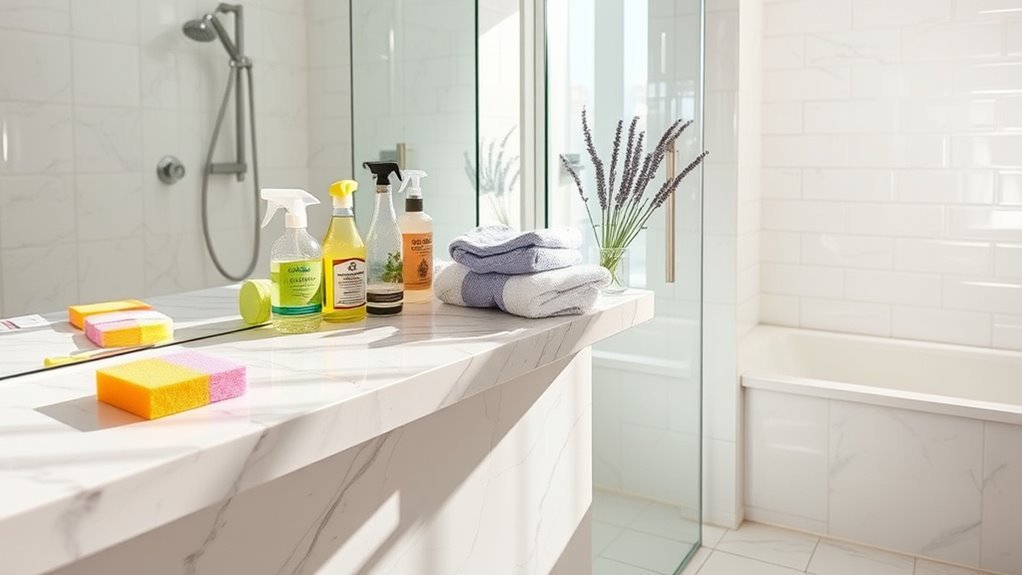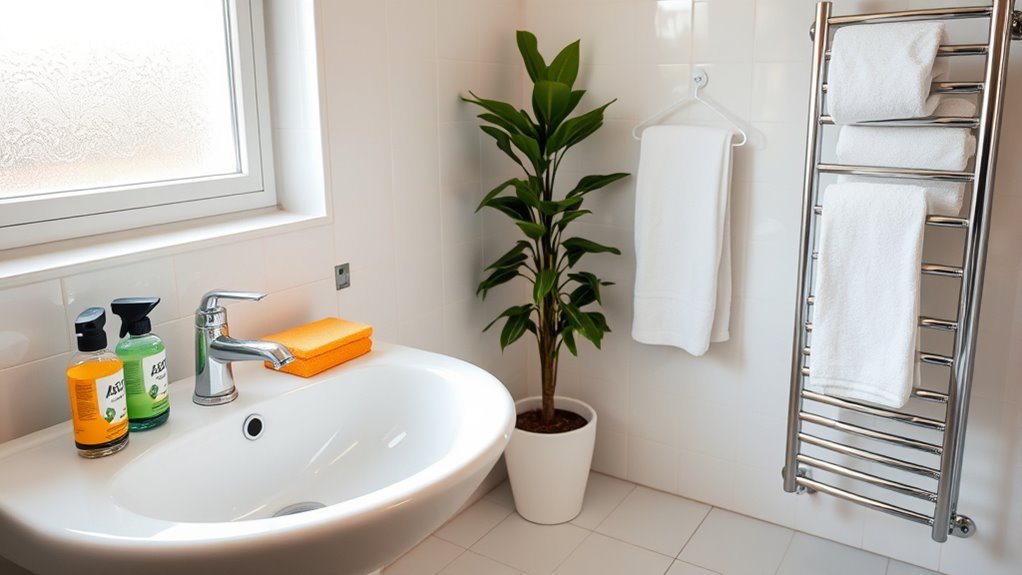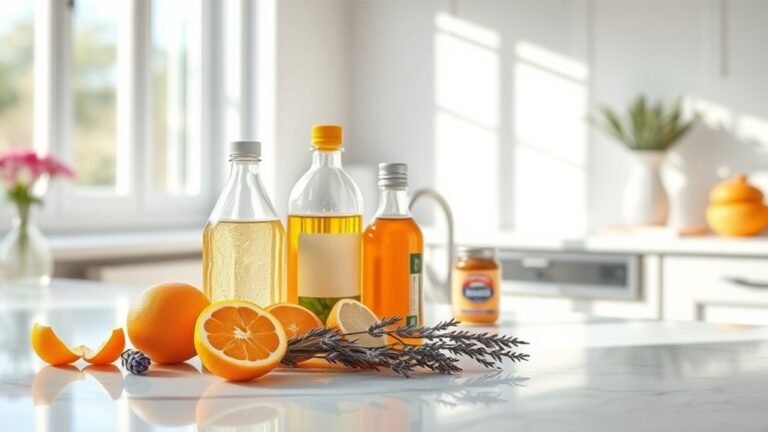The Ultimate Guide to Deep Cleaning Your Bathroom
To deep clean your bathroom effectively, start by clearing surfaces and gathering essentials like all-purpose cleaners, grout brushes, microfiber cloths, and gloves. Tackle tiles and grout with baking soda or vinegar solutions, and scrub your tub and shower thoroughly to remove soap scum. Don’t forget to disinfect the toilet and fight mold with vinegar mixtures. Organize storage by decluttering and using bins, then maintain freshness with daily wipes and ventilation. Keep going to discover detailed tips for a sparkling, healthy bathroom!
Preparing Your Bathroom for Deep Cleaning

Before diving into the deep cleaning process, you’ll want to prepare your bathroom properly to make the task easier and more effective. Start by evaluating your bathroom layout so you can tackle each area logically—this prevents wasted effort and helps you move freely. Clear countertops, remove rugs, and take out any items that might get in your way. Next, establish a cleaning schedule that fits your lifestyle, breaking down tasks into manageable chunks. This way, deep cleaning won’t feel overwhelming, and you’ll maintain that fresh, free atmosphere you crave. By prepping thoughtfully, you set yourself up for success, turning what could be a chore into a liberating experience where you reclaim your space efficiently and effortlessly.
Essential Cleaning Supplies and Tools
You’ll need a handful of essential cleaning supplies and tools to tackle your bathroom deep cleaning efficiently. Start with a good all-purpose cleaner, disinfectant spray, and a grout brush for stubborn spots. Grab microfiber cloths and sponges—they’re perfect for wiping down surfaces without scratching. Rubber gloves protect your skin, while a sturdy scrub brush helps with tougher grime. Don’t forget a squeegee to keep mirrors and glass streak-free. Organizing tools like caddies or bins keep everything within easy reach and prevent clutter during your cleaning spree. Having these essentials ready means you’re free to move through your space quickly and effectively, turning your bathroom into a spotless haven without hassle. Ready to plunge into it? Your bathroom refresh starts here.
How to Clean and Disinfect Bathroom Tiles and Grout

Now that your cleaning supplies are ready, it’s time to focus on the bathroom tiles and grout, which often harbor dirt and mildew. Start by scrubbing grout lines with a brush and a mix of baking soda and water or a mild cleaner. For stubborn stains, a vinegar solution works wonders—but avoid it on natural stone tiles. After cleaning, rinse thoroughly and dry the area. To keep grout fresh and prevent future buildup, apply grout sealing. This step locks out moisture and grime, giving you lasting freedom from constant scrubbing. Finally, give your tiles a shine by polishing them with a suitable tile polish or a microfiber cloth. This not only enhances their look but also adds a protective layer to keep your bathroom gleaming longer.
Effective Methods for Cleaning the Bathtub and Shower
Because bathtubs and showers are constantly exposed to soap scum, hard water stains, and mildew, they need regular, thorough cleaning to stay fresh and hygienic. Knowing your bathtub materials can help you choose the right cleaner without damaging surfaces. Don’t forget your shower curtains—they harbor mold and need attention too. Here’s how to keep things spotless:
- Use a gentle, non-abrasive cleaner suited for your bathtub materials.
- Spray a vinegar and water solution to tackle soap scum and hard water stains.
- Let the cleaner sit for 10-15 minutes before scrubbing with a soft brush.
- Wash or replace shower curtains regularly to prevent mildew build-up.
- Rinse everything thoroughly and dry surfaces to avoid water spots and mold growth.
This routine frees you from grime, keeping your bathroom inviting and fresh.
Tips for Scrubbing and Sanitizing Bathroom Sinks and Faucets

When cleaning your bathroom sinks and faucets, choosing the right cleaning solutions is key to cutting through grime without damage. You’ll want to use proper scrubbing techniques to avoid scratches and guarantee every corner gets sanitized. Let’s look at how to tackle these areas effectively for a sparkling finish.
Effective Cleaning Solutions
To keep your bathroom sinks and faucets sparkling, you’ll need a few reliable cleaning solutions that tackle grime and germs effectively. Embracing natural cleaners and homemade solutions not only frees you from harsh chemicals but also gives you control over what touches your surfaces. Here are five effective options you can try:
- White vinegar mixed with water to dissolve mineral deposits
- Baking soda paste for gentle scrubbing without scratching
- Lemon juice’s natural acidity to cut through soap scum and add shine
- Castile soap diluted with water for a mild yet powerful clean
- Tea tree oil drops added to any mix for antibacterial properties
These choices empower you to maintain a fresh, clean bathroom while staying true to your freedom from toxic products.
Proper Scrubbing Techniques
A proper scrubbing technique can make all the difference in keeping your bathroom sinks and faucets spotless and germ-free. When you scrub, focus on applying effective pressure without damaging surfaces. Use a soft-bristle brush or non-abrasive sponge to reach tight spots and avoid scratches. Start by wetting the area, then apply your chosen cleaner, allowing it to sit briefly for better germ removal. Scrub in circular motions, concentrating on faucet bases and drain edges where grime builds up. Rinse thoroughly to wash away residue. Remember, consistent scrubbing techniques not only maintain cleanliness but also extend the life of your fixtures, giving you the freedom to enjoy a fresh and hygienic bathroom without extra hassle. Keep it simple, effective, and your bathroom will thank you.
Best Practices for Cleaning and Maintaining the Toilet
When it comes to your toilet, using the right bowl cleaning techniques is key to keeping it spotless. You’ll also want to use effective disinfecting methods to kill germs and keep everything hygienic. Finally, preventing stains before they set will save you time and effort in the long run.
Toilet Bowl Cleaning Techniques
Although cleaning the toilet bowl might seem straightforward, using the right techniques can make a big difference in hygiene and maintenance. To keep your toilet fresh and free of buildup, you’ll want to master effective toilet brush techniques and choose the right toilet bowl cleaners. Here’s how you can do it:
- Apply toilet bowl cleaner generously under the rim and let it sit.
- Use firm, circular strokes with your toilet brush, focusing on stains and waterlines.
- Don’t forget to scrub under the rim where grime hides.
- Flush while brushing to rinse the brush and bowl simultaneously.
- Rinse your brush with clean water and store it in a dry holder to avoid bacteria growth.
These simple habits give you freedom from stubborn stains and keep your bathroom inviting.
Effective Disinfecting Methods
Since the toilet is one of the most frequently used spots in your bathroom, you’ll want to disinfect it thoroughly to prevent germs and odors. To keep things fresh and safe, consider natural disinfecting options like vinegar or hydrogen peroxide, which effectively kill bacteria without harsh chemicals. Make sure to disinfect all surfaces—inside the bowl, the seat, and the flush handle—since germs love to hide in these spots. Keep your disinfecting frequency consistent; ideally, clean your toilet at least once a week to stay ahead of buildup and bacteria. This routine not only protects your health but also gives you the freedom to enjoy a clean bathroom without stress. Stick to these simple, effective methods for maintaining a truly fresh toilet.
Preventing Toilet Stains
To keep your toilet looking spotless, you’ll want to tackle stains before they have a chance to set in. Preventing toilet bowl stains not only keeps your bathroom fresh but also saves you time and effort later. Here’s how to maintain a clean toilet bowl with ease:
- Clean the toilet bowl regularly using a brush and mild cleaner.
- Use a pumice stone gently to remove early mineral deposits.
- Keep the lid closed to reduce airborne dust and debris.
- Avoid letting water sit stagnant by flushing frequently or after each use.
- Use stain prevention tablets designed for toilets that dissolve slowly.
Removing Mold and Mildew From Bathroom Surfaces
Mold and mildew thrive in the damp environment of your bathroom, making them common and stubborn problems. To tackle mildew removal effectively, start by mixing equal parts white vinegar and water in a spray bottle. Spray the affected areas and let it sit for about 15 minutes before scrubbing with a brush or sponge. For tougher mold, a baking soda paste works wonders—apply, scrub, then rinse thoroughly. Consistent mold prevention is key, so keep your bathroom well-ventilated by opening windows or using an exhaust fan. Wipe down wet surfaces regularly to cut moisture buildup. By staying proactive and using these simple techniques, you’ll keep your bathroom fresh and mold-free, giving you the freedom to enjoy a clean, healthy space without hassle.
Cleaning Mirrors and Glass Without Streaks
A spotless mirror can instantly brighten your bathroom, but streaks often get in the way of that perfect shine. To enjoy freedom from annoying smudges, you’ll want to use effective streak free solutions and master glass polishing techniques. Here’s how to get your mirrors gleaming:
- Use a microfiber cloth instead of paper towels to avoid lint.
- Spray a mix of vinegar and water or a commercial streak free solution.
- Wipe in a circular motion, then finish with vertical strokes for clarity.
- Avoid cleaning mirrors in direct sunlight to prevent quick drying and streaks.
- Buff gently with a dry cloth to enhance shine and remove any residual streaks.
With these tips, you’ll free yourself from streaks and enjoy a crystal-clear reflection every time.
Organizing and Decluttering Bathroom Storage Areas
Although it’s easy to overlook, cluttered bathroom storage can make your space feel cramped and chaotic. To regain freedom in your bathroom, start by emptying all storage areas. Sort through your items and toss anything expired or unused. Use decluttering tips like grouping similar items together and storing daily essentials within easy reach. Consider adding baskets or clear containers to keep things tidy and visible. Vertical storage options can maximize space without crowding your bathroom. Remember, less clutter means less stress, so be honest about what you really need. With organized bathroom storage, your space will feel open and rejuvenating, making your daily routine smoother and more enjoyable. Taking control of your storage is a simple step toward a freer, cleaner bathroom.
Maintaining a Fresh and Clean Bathroom Between Deep Cleans
Even if you’ve just finished a thorough deep clean, keeping your bathroom fresh between sessions takes consistent effort. Daily upkeep is key to maintaining that freedom from grime and odors. Focus on simple, effective habits that keep fresh scents lingering and messes at bay without feeling like a chore. Try these tips:
- Wipe down sinks and counters daily to prevent buildup.
- Use a squeegee on shower walls to stop water stains.
- Empty trash and replace liners regularly to avoid odors.
- Open windows or run a fan to circulate air and reduce moisture.
- Place natural air fresheners like essential oil diffusers for continuous fresh scents.
With these easy steps, your bathroom stays inviting and clean, freeing you from constant deep cleaning stress.
Frequently Asked Questions
How Often Should I Deep Clean My Bathroom for Optimal Hygiene?
You should deep clean your bathroom at least once a week to keep things fresh and hygienic. Sticking to a weekly maintenance routine helps prevent buildup and keeps germs at bay without feeling overwhelming. Setting up a sanitation schedule that fits your lifestyle gives you freedom from last-minute scrambles and guarantees your space stays spotless. Consistency is key, so find what works for you and enjoy a clean, worry-free bathroom!
Are Natural Cleaning Products as Effective as Chemical Cleaners?
Did you know that 70% of people prefer natural ingredients in their cleaning products for a safer home? When you choose natural cleaners, you’re embracing freedom from harsh chemicals while still getting solid cleaning effectiveness. While chemical cleaners can be powerful, many natural options like vinegar or baking soda work just as well for everyday grime. You can keep your space fresh and healthy without compromising your values or the shine you want.
Can Deep Cleaning Prevent Plumbing Issues in My Bathroom?
Absolutely, deep cleaning can help with clog prevention by removing buildup before it causes blockages. When you regularly clear drains and fixtures, you’re basically giving your plumbing a fresh start. Pair this with simple maintenance tips like avoiding flushing anything other than waste and using strainers in sinks. Taking these steps frees you from unexpected plumbing headaches, letting you enjoy your bathroom without worry or inconvenience.
What Is the Best Way to Dispose of Old Bathroom Cleaning Products?
When wondering where to wisely waste worn-out washroom wipes or liquids, you’ll want to choose eco-friendly disposal. Don’t dump hazardous waste down drains or in trash; instead, seek special sites or services that safely handle such substances. You’re free to protect your planet and plumbing by following local laws and guidelines for disposing of old bathroom cleaners. This way, you’re safeguarding your space and the environment with care and conscience.
How Can I Make My Bathroom Smell Fresh Without Using Air Fresheners?
You can keep your bathroom smelling fresh without air fresheners by using essential oils and odor absorbers. Try placing a few drops of your favorite essential oil on cotton balls or a small cloth, then tuck them discreetly around the room. Activated charcoal or baking soda works wonders as natural odor absorbers—just set them out in open containers. These simple tricks give you freedom from synthetic scents and keep your space naturally inviting.






